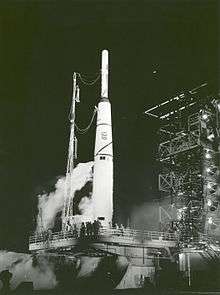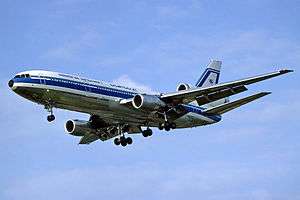McDonnell Douglas
 Following McDonnell Douglas's merger with Boeing in 1997, a simplified version of this logo was added to the Boeing logo. | |
| Industry | Aerospace |
|---|---|
| Fate | Merged with Boeing |
| Predecessor | |
| Successor | The Boeing Company |
| Founded | April 28, 1967 |
| Defunct | August 1, 1997 (merger date)[1] |
| Headquarters | Berkeley, Missouri, US |
| Products | Aircraft, missiles, rockets, space components |
| Website | mdc.com (archived copy) |
McDonnell Douglas was a major American aerospace manufacturing corporation and defense contractor formed by the merger of McDonnell Aircraft and the Douglas Aircraft Company in 1967. Between then and its own merger with Boeing in 1997, it produced a number of well-known commercial and military aircraft such as the DC-10 airliner and F-15 Eagle air-superiority fighter.
The corporation was based at Lambert–St. Louis International Airport near St. Louis, Missouri, while the headquarters for its subsidiary, the McDonnell Douglas Technical Services Company (MDTSC), were established in unincorporated St. Louis County, Missouri.[2]
History
Background
The company was formed from the firms of James Smith McDonnell and Donald Wills Douglas in 1967. Both men were of Scottish ancestry, graduates of MIT and had worked for the aircraft manufacturer Glenn L. Martin Company.[3]
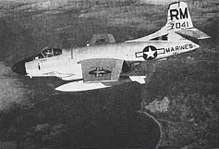
Douglas had been chief engineer at Martin before leaving to establish Davis-Douglas Company in early 1920 in Los Angeles. He bought out his backer and renamed the firm the Douglas Aircraft Company in 1921.[4] McDonnell founded J.S. McDonnell & Associates in Milwaukee, Wisconsin in 1926. His idea was to produce a personal aircraft for family use. The economic depression from 1929 ruined his ideas and the company collapsed. He worked at three companies with the final being Glenn Martin Company in 1933. He left Martin in 1938 to try again with his own firm, McDonnell Aircraft Corporation, this time based at Lambert Field, outside St. Louis, Missouri.[5]
World War II was a major earner for Douglas. The company produced almost 30,000 aircraft (Douglas DC-3) from 1942 to 1945 and the workforce swelled to 160,000. Both companies suffered at the end of hostilities, facing an end of government orders and a surplus of aircraft.
After the war, Douglas continued to develop new aircraft, including the DC-6 in 1946 and the DC-7 in 1953.[6][7] The company moved into jet propulsion, producing its first for the military – the conventional F3D Skyknight in 1948 and then the more 'jet age' F4D Skyray in 1951.[8] In 1955, Douglas introduced the first attack jet of the United States Navy with the A4D Skyhawk.[9] Designed to operate from the decks of the World War II Essex class aircraft carriers, the Skyhawk was small, reliable, and tough. Variants of it continued in use in the Navy for almost 50 years,[10] finally serving in large numbers in a two-seat version as a jet trainer.[11]
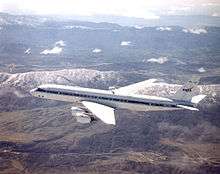
Douglas also made commercial jets, producing the DC-8 in 1958 to compete with the Boeing 707.[12][13] McDonnell was also developing jets, but being smaller it was prepared to be more radical, building on its successful FH-1 Phantom to become a major supplier to the Navy with the F2H Banshee and F3H Demon; and producing the F-101 Voodoo for the United States Air Force (USAF).[14][15] The Korean War-era Banshee and later the F-4 Phantom II produced during the Vietnam War helped push McDonnell into a major military fighter supply role.[16] Douglas created a series of experimental high-speed jet aircraft in the Skyrocket family, with the Skyrocket DB-II being the first aircraft to travel at twice the speed of sound in 1953.
Both companies were eager to enter the new missile business, Douglas moving from producing air-to-air rockets and missiles to entire missile systems under the 1956 Nike program and becoming the main contractor of the Skybolt ALBM program and the Thor ballistic missile program.[17][18] McDonnell made a number of missiles, including the unusual ADM-20 Quail,[19] as well as experimenting with hypersonic flight, research that enabled it to gain a substantial share of the NASA projects Mercury and Gemini. Douglas also gained contracts from NASA, notably for part of the enormous Saturn V rocket.[20][21]
The two companies were now major employers, but both were having problems. Douglas was strained by the cost of the DC-8 and DC-9, while McDonnell suffered lean times during any downturns in military procurement. The two companies began to sound each other out about a merger. Inquiries began in 1963; Douglas offered bid invitations from December 1966 and accepted that of McDonnell.[22] The two firms were officially merged on April 28, 1967 as the McDonnell Douglas Corporation (MDC).[23][24] The two companies seemed to be a good fit for each other; McDonnell was primarily a defense contractor while Douglas sold mostly civil aircraft.
Formation
McDonnell Douglas retained McDonnell Aircraft's headquarters location at what was then known as Lambert–St. Louis International Airport, in Berkeley, Missouri,[25][26][27][28] near St. Louis.
In 1967, with the merger of McDonnell and Douglas Aircraft, David S. Lewis, then president of McDonnell Aircraft, was named chairman of what was called the Long Beach, Douglas Aircraft Division. At the time of the merger, Douglas Aircraft was estimated to be less than a year from bankruptcy. Flush with orders, the DC-8 and DC-9 aircraft were 9 to 18 months behind schedule, incurring stiff penalties from the airlines. Lewis was active in DC-10 sales in an intense competition with Lockheed's L-1011, a rival tri-jet aircraft.[29][30][31] In two years, Lewis had the operation back on track and in positive cash flow. He returned to the company's St. Louis headquarters where he continued sales efforts on the DC-10 and managed the company as a whole as President and chief operating officer through 1971.
The DC-10 began production in 1968 with the first deliveries in 1971.[32] Several artists impressions exist of an aircraft named the "DC-10 Twin" or DC-X which McDonnell Douglas considered in the early 1970s but never built.[33][34] This would have been an early twinjet similar to the later Airbus A300, but never progressed to a prototype. This could have given McDonnell Douglas an early lead in the huge twinjet market that subsequently developed, as well as commonality with much of the DC-10's systems.[35]
1970–1980
In 1977, the next generation of DC-9 variants, dubbed the "Super 80" (later renamed the MD-80) series, was launched.[36]
.jpg)
In 1977, the KC-10 Extender was the second McDonnell Douglas transport aircraft to be selected for use by the US Air Force;[37] the first being the C-9 Nightingale/Skytrain II.
Through the years of the Cold War McDonnell Douglas had introduced and manufactured dozens of successful military aircraft, including the F-15 Eagle in 1974,[38] the F/A-18 Hornet in 1978,[39] and other products such as the Harpoon and Tomahawk missiles. The oil crisis of the 1970s was a serious shock to the commercial aviation industry, as a major manufacturer of commercial aircraft at the time, McDonnell Douglas was hit by the economic shift and forced to contract heavily while diversifying into new areas to reduce the impact of potential future downturns.
1980–1989
In 1984, McDonnell Douglas expanded into helicopters by purchasing Hughes Helicopters from the Summa Corporation for $470 million.[40] Hughes Helicopters was made a subsidiary initially and renamed McDonnell Douglas Helicopter Systems in August 1984.[41] McDonnell Douglas Helicopters's most successful product was the Hughes-designed AH-64 Apache attack helicopter.[42][43]
In 1986, MD-11 was launched, an improved and upgraded version of DC-10.[44][45][46][47] The MD-11 was the most advanced trijet aircraft to be developed. It sold 200 units, but was discontinued in 2001 after the merger with Boeing as it competed with the Boeing 777.[44][48][49][50] The final commercial aircraft design to be made by McDonnell Douglas came in 1988. The MD-90 was a stretched version of the MD-80,[46] equipped with International Aero Engines V2500 turbofans, the largest rear-mounted engines ever on a commercial jet. The MD-95, a modern regional airliner closely resembling the DC-9-30, was the last McDonnell Douglas designed commercial jet produced.[51][52]
On January 13, 1988, McDonnell Douglas and General Dynamics won the US Navy Advanced Tactical Aircraft (ATA) contract. The US$4.83 billion contract was to develop the A-12 Avenger II, a stealth, carrier-based, long-range flying wing attack aircraft that would replace the A-6 Intruder.
In January 1989, Robert Hood was appointed to lead McDonnell Douglas, replacing retiring Worsham. McDonnell Douglas then introduced a major reorganization called the Total Quality Management System (TQMS). TQMS ended the functional setup where engineers with specific expertise in aerodynamics, structural mechanics, materials, and other technical areas worked on several different aircraft. This was replaced by a product-oriented system where they focus on one specific airplane. As part of reorganization, 5,000 managerial and supervisory positions were eliminated at Douglas. The former managers could apply for 2,800 newly created posts; the remaining 2,200 would lose their managerial responsibilities.[53] The reorganization reportedly led to widespread loss of morale at the company and TQMS was nicknamed "Time to Quit and Move to Seattle" by employees referring to the competitor Boeing headquartered in Seattle, WA.[54]
1990–1997
Technical issues, development cost overruns, growing unit costs, and delays led to the termination of the A-12 Avenger II program on January 13, 1991, by Defense Secretary Dick Cheney. Years of litigation would proceed over the contract's termination: the government claimed that the contractors had defaulted on the contract and were not entitled to the final progress payments, while McDonnell Douglas and General Dynamics believed that the contract was terminated out of convenience, and thus the money was owed.[55] The case was contested through litigation until a settlement was reached in January 2014. The chaos and financial stress created by the collapse of the A-12 program led to the layoff of 5,600 employees.[56] The advanced tactical aircraft role vacated by the A-12 debacle would be filled by another McDonnell Douglas program, the F/A-18E/F Super Hornet.[39][57]
However the purchasing of aircraft was curtailed as the Cold War came to an abrupt end in the 1990s. This curtailment in military procurements combined with the loss of the contracts for two major projects, the Advanced Tactical Fighter and Joint Strike Fighter, severely hurt McDonnell Douglas.[48][58] McDonnell Douglas built only a small wind tunnel test model.[59][60]
In 1991, MD-11 was not quite a success, ongoing tests of the MD-11 revealed a significant shortfall in the aircraft's performance. An important prospective carrier, Singapore Airlines, required a fully laden aircraft that could fly from Singapore to Paris, against strong headwinds during mid-winter; the MD-11 did not have sufficient range for this at the time.[61] Due to the less-than-expected performance figures, Singapore Airlines cancelled its 20-aircraft MD-11 order on August 2, 1991, and ordered 20 A340-300s instead.[62]

In 1992, McDonnell Douglas unveiled a study of a double deck jumbo-sized aircraft designated MD-12.[35][63] Despite briefly leaving the market, the study was perceived as merely a public relations exercise to disguise the fact that MDC was struggling under intense pressure from Boeing and Airbus. It was clear to most in the industry that MDC had neither the resources nor the money to develop such a large aircraft,[64] and the study quickly sank without a trace. A similar double deck concept was used in Boeing's later Ultra-Large Aircraft study intended to replace the 747,[65][66] but ultimately the double deck concept would not see the light of day until the Airbus A380 in the 2000s.[67][68]
Following Boeing's 1996 acquisition of Rockwell's North American division, McDonnell Douglas merged with Boeing in August 1997 in a US $13 billion stock swap, with Boeing as the surviving company.[1][58] Boeing adopted the McDonnell Douglas logo, which shows the globe being encircled in tribute to the first aerial circumnavigation which was accomplished in 1924 using Douglas aircraft.
McDonnell Automation Company legacy
Some of the company's lasting legacies are non-aviation-related. They are the computer systems and companies developed in the company's subsidiary McDonnell Automation Company (McAuto) which was created in the 1950s initially used for numerical control for production starting in 1958 and computer-aided design (CAD) starting in 1959. Its CAD program MicroGDS remains in use with the latest official version 11.3 issued in June 2013.[69][70]
By the 1970s McAuto with 3,500 employees and $170 million worth of computer equipment was one of the largest computer processors in the world.[70]
In 1981, McAuto began processing medical claims after it acquired Bradford Systems and Administrative Services for $11.5 million.[71] In 1983 two principals of Bradford who had to come work at McAuto left to form the Sanus Corporation health maintenance organization. The St. Louis office of Sanus was wholly owned by McDonnell Douglas.[72] McDonnell Douglas personnel including Joseph T. Lynaugh and Howard L. Waltman[73] formed Sanus in 1983. In 1986 after McDonnell Douglas reduced its control, Sanus announced a partnership with St. Louis pharmacy Medicare Glaser to form Express Scripts with the pharmacy providing drugs for the Sanus HMO. Charles H. Ridings, formerly in charge of McDonnell Douglas mergers and acquisitions, was named the first chief executive (although he was quickly replaced by Waltman).[74] The new company soon abandoned the HMO business to become with the country's largest independent pharmacy benefit management organization and became the 22nd largest company in the U.S. in 2017 with revenue exceeding $100 billion—making it far larger than McDonnell Douglas. Five new Express Scripts buildings now sit on the east side of Lambert Airport along I-70.
Products
Military airplanes
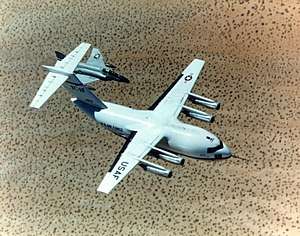
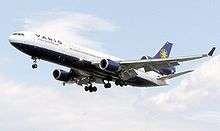
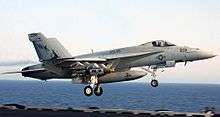

- McDonnell Douglas A-4 Skyhawk (started under Douglas Aircraft, used by the Blue Angels)
- McDonnell Douglas F-4 Phantom II (started under McDonnell Aircraft, used by the Blue Angels and Thunderbirds)
- McDonnell Douglas C-9
- McDonnell Douglas F-15 Eagle
- McDonnell Douglas AV-8B Harrier II (based on the British Aerospace Harrier)
- McDonnell Douglas F/A-18 Hornet (used by the Blue Angels)
- McDonnell Douglas YC-15
- McDonnell Douglas T-45 Goshawk jet trainer (based on the British Aerospace Hawk)
- McDonnell Douglas KC-10 Extender
- McDonnell Douglas C-17 Globemaster III (Design and early production)
- McDonnell Douglas A-12 Avenger II
- F/A-18E/F Super Hornet (Initial design and early production)
Commercial airplanes
- McDonnell Douglas DC-8 (started under Douglas Aircraft)
- McDonnell Douglas DC-9 (started under Douglas Aircraft)
- McDonnell Douglas DC-10 (with cockpit upgrade designated MD-10)
- McDonnell Douglas MD-11 (stretched and modernized version of the DC-10)
- McDonnell Douglas MD-80 (stretched and modernized version of the DC-9)
- McDonnell Douglas MD-90 (stretched and modernized version of the MD-80)
- MD-95 (latest evolution of the DC-9, sold as Boeing 717)
Experimental aircraft
Proposed models
- McDonnell Douglas MD-12, a double-decker plane similar to the Airbus A380 and Boeing NLA.
- McDonnell Douglas MD-94X
Helicopters
- AH-64 Apache (started under Hughes Helicopters)
- MD 500 series (started under Hughes Helicopters)
- MD 600
- MD 901/902/902 Explorer
Manned spacecraft
- Big Gemini
- Skylab space station
- Skylab B
- McDonnell Douglas DC-X
Computer systems
- Sequel
- Spirit
- Reality OS
- Series 18 Model 6
- Series 18 Model 9
- Sovereign
- 6200
- 6400
- 7000
- 9000
- 9200
- 9400
The corporation also produced the Sovereign (later M7000) series of systems in the UK, which used the Sovereign operating system developed in the UK and which was not based on Pick, unlike the "Reality" family of systems listed above. Sovereign, largely a Data Entry solution, had a reasonable market in the United States supporting data entry shops.[75]
Missiles and rockets
- BGM-109 Tomahawk missile
- Harpoon missile
- LIM-49 Spartan
- M47 Dragon
- Delta II rocket
Commercial deliveries
| DC-8 | DC-9 | DC-10 | MD-80 | MD-90 | MD-11 | Total | |
|---|---|---|---|---|---|---|---|
| 1959 | 21 | 21 | |||||
| 1960 | 91 | 91 | |||||
| 1961 | 42 | 42 | |||||
| 1962 | 22 | 22 | |||||
| 1963 | 19 | 19 | |||||
| 1964 | 20 | 20 | |||||
| 1965 | 31 | 5 | 36 | ||||
| 1966 | 32 | 69 | 101 | ||||
| 1967 | 41 | 153 | 194 | ||||
| 1968 | 102 | 202 | 304 | ||||
| 1969 | 85 | 122 | 207 | ||||
| 1970 | 33 | 51 | 84 | ||||
| 1971 | 13 | 46 | 13 | 72 | |||
| 1972 | 4 | 32 | 52 | 88 | |||
| 1973 | 29 | 57 | 86 | ||||
| 1974 | 48 | 47 | 95 | ||||
| 1975 | 42 | 43 | 85 | ||||
| 1976 | 50 | 19 | 69 | ||||
| 1977 | 22 | 14 | 36 | ||||
| 1978 | 22 | 18 | 40 | ||||
| 1979 | 39 | 35 | 74 | ||||
| 1980 | 18 | 41 | 5 | 64 | |||
| 1981 | 16 | 25 | 61 | 102 | |||
| 1982 | 10 | 11 | 34 | 55 | |||
| 1983 | 12 | 51 | 63 | ||||
| 1984 | 10 | 44 | 54 | ||||
| 1985 | 11 | 71 | 82 | ||||
| 1986 | 17 | 85 | 102 | ||||
| 1987 | 10 | 94 | 104 | ||||
| 1988 | 10 | 120 | 130 | ||||
| 1989 | 1 | 117 | 118 | ||||
| 1990 | 139 | 3 | 142 | ||||
| 1991 | 140 | 31 | 171 | ||||
| 1992 | 84 | 42 | 126 | ||||
| 1993 | 43 | 36 | 79 | ||||
| 1994 | 23 | 17 | 40 | ||||
| 1995 | 18 | 13 | 18 | 49 | |||
| 1996 | 12 | 25 | 15 | 52 | |||
| 1997 | 16 | 26 | 12 | 54 | |||
| 1998 | 8 | 34 | 12 | 54 | |||
| 1999 | 26 | 13 | 8 | 47 | |||
| 2000 | 5 | 4 | 9 | ||||
| 2001 | 2 | 2 | |||||
| Total | 556 | 976 | 446 | 1,191 | 116 | 200 | 3,485 |
| Active[77][78] | 2 | 32 | 50 | 404 | 65 | 123 | 676 |
| DC-8 | DC-9 | DC-10 | MD-80 | MD-90 | MD-11 |
Key people
Footnotes
- 1 2 Boeing Chronology, 1997–2001 Archived January 2, 2013, at the Wayback Machine. at boeing.com.
- ↑ Welcome!, the former McDonnell Douglas Technical Services Company's homepage (January 24, 1997; retrieved June 4, 2009).
- ↑ Yenne 1985, pp. 6–9.
- ↑ Yenne 1985, pp. 10–12.
- ↑ Leiser, Ken. "St. Louis aviation honored". St. Louis Post-Dispatch, August 28, 2009. Archived August 29, 2009, at the Wayback Machine.
- ↑ Johnston, Stanley (February 17, 1946). "Douglas DC-4 and DC-6 Skymasters". Chicago Tribune.
- ↑ "DC-7, newest Douglas Airliner, takes to sky". Los Angeles Times. May 19, 1953.
- ↑ "U.S. Jet set mark, flies 753.4 M.P.H: Navy Hero recaptures World Speed leadership – Bests week-old British record". New York Times. October 4, 1953.
- ↑ "Bantam Jet Bomber is unveiled by Navy". Hartford Courant. June 8, 1954.
- ↑ "Saying goodbye to the A-4 Skyhawk". The Virginian. July 17, 1993.
- ↑ Ray, Nancy (September 16, 1991). "Aircraft pioneer, 83, savors bold designs that still fly". Los Angeles Times.
- ↑ Miles, Marvin (May 31, 1958). "Douglas Jetliner, most advanced of nation, debuts in test flight". Los Angeles Times.
- ↑ Miles, Marvin (August 24, 1961). "A DC-8 is first Airliner to top speed of Sound". New York Times.
- ↑ "Navy awards contract for new jet fighter". Hartford Courant. August 17, 1952.
- ↑ "Navy accepts first Demon jet". Los Angeles Times. January 9, 1954.
- ↑ O'neil, Tim (May 24, 2009). "The Phantom of the factory: A Look Back – The F-4 Phantom II, rolled out in late May 1958, became one of the great success stories of military aviation and supported thousands of families". St Louis Post.
- ↑ "Skybolt fired Successfully". Kentucky New Era. December 20, 1962.
- ↑ Shannon, Don (May 9, 1958). "Thor hinted as favorite missile". Los Angeles Times.
- ↑ Witkin, Richard (May 8, 1960). "Missiles extend life of bomber: Jets, once thought obsolete, will soon carry deadly Air-Ground rockets". New York Times.
- ↑ "Douglas Saturn contract grows $48 Million". Los Angeles Times. December 22, 1963.
- ↑ Schonberger, Ernest A (October 5, 1967). "$170.5-Million job won by McDonnell Douglas". Los Angeles Times.
- ↑ Wright, Robert (January 26, 1967). "McDonnell and Douglas take a giant step". New York Times.
- ↑ "Douglas, McDonnell aircraft firms announce merger plans". The Bulletin. (Bend, Oregon). UPI. January 13, 1967. p. 6.
- ↑ "McDonnell Douglas merger cleared". Fort Scott Tribune. April 27, 1967.
- ↑ Ealy, Charles and Andy Dworkin. "Texas Instruments may sell defense unit McDonnell Douglas among 1st to show interest." The Dallas Morning News. November 6, 1996. Retrieved June 12, 2009.
- ↑ "Berkeley city, Missouri." U.S. Census Bureau. Retrieved June 8, 2009.
- ↑ "Berkeley, MO (1990) Tiger Map Archived June 7, 2000, at the Wayback Machine.." U.S. Census Bureau. Retrieved June 13, 2009.
- ↑ Bower, Carolyn. "TESTS FIND RADIOACTIVE MATERIAL." St. Louis Post-Dispatch. December 9, 1988. News 2F. Retrieved June 13, 2009.
- ↑ Wood, Charles (June 6, 1972). "DC-10 deal also pleases Lockheed". Los Angeles Times.
- ↑ Wright, Robert (March 11, 1974). "Lockheed seeking greater range for Tristar; hopes to make its jet more competitive". New York Times.
- ↑ Wood, Robert (June 12, 1971). "L-1011 Customers admit concessions by Douglas". Los Angeles Times.
- ↑ Steiger, Paul (July 30, 1971). "Airlines take over 1st DC-10s as McDonnell Gibes Lockheed". Los Angeles Times.
- ↑ Getze, John (November 22, 1972). "Douglas takes 1st Step toward Twin Engine version of DC-10". Los Angeles Times.
- ↑ Buck, Thomas (April 14, 1973). "Douglas plans wide-bodied jet with short-medium ranges". Chicago Tribune.
- 1 2 "Clipped Wings". Flight International. December 20, 2005.
- ↑ Redburn, Tom (October 3, 1977). "McDonnell to build larger, quieter DC-9". Los Angeles Times.
- ↑ "US Air Force using McDonnell Douglas KC-10 advanced tanker-cargo aircraft for 5 years". PR Newswire. March 17, 1986.
- ↑ Williams, Bob (May 10, 1981). "7 Aerospace Firms Take $50-Million Gamble on Advanced F-15 Fighter". Los Angeles Times.
- 1 2 "Pentagon gives Navy Go-Ahead on costly Douglas F-18 fighter". Los Angeles Times. June 30, 1981.
- ↑ "McDonnell Douglas completes Hughes Helicopter acquisition". Chicago Tribune. January 8, 1984.
- ↑ Richardson, Doug and Lindsay Peacock. Combat Aircraft AH-64, pp. 14–15. London: Salamander Books, 1992. ISBN 0-86101-675-0.
- ↑ Western, Ken (March 22, 1997). "McDonnell Douglas' Apache Longbow makes its debut". Arizona Republic.
- ↑ Flannery, William (April 8, 1995). "Mcdonnell wins big helicopter contract but layoffs are looming at commercial air unit". St Louis Post.
- 1 2 "Aircraft profile: MD-11". Al Jazeera. Retrieved January 7, 2010.
- ↑ Brooks, Nancy (December 18, 1986). "McDonnell gets order it needs to launch MD-11 SAS request for 12 new jets brings total to 26". Los Angeles Times.
- 1 2 Cohen, Aubrey (December 28, 2009). "Did subsidies drive MD and Lockheed from commercial jet biz?". Seattle PI.
- ↑ Wiener, Eric (February 14, 1990). "McDonnell's less costly new jet". New York Times.
- 1 2 Pae, Peter (February 22, 2001). "Last Plane Out for Aerospace Pioneer; Aviation: Ceremony today marks the delivery of the last commercial aircraft built under the McDonnell Douglas name". Los Angeles Times.
- ↑ "American Airlines retires last MD-11 from fleet". Knight Ridder/Tribune Business News. October 16, 2001.
- ↑ Demarco, Peter (September 19, 2000). "MD-11 Jet has highest crash rate". New York Daily Times. Archived from the original on June 29, 2009.
- ↑ Lane, Polly (November 3, 1997). "MD-95'S future uncertain – Boeing to phase uut MD-80, MD-90". Seattle Times.
- ↑ Weintraub, Richard (February 14, 1993). "MD-90 Airliner unveiled by McDonnell Douglas: firm seeks to stay in civilian aircraft business". Washington Post.
- ↑ Henkoff, Ronald. "BUMPY FLIGHT AT MCDONNELL DOUGLAS Even before two DC-10 crashes, it was beset by defense cutbacks and factory foul-ups. Now managers must unsnarl a new reorganization to get airborne again". Fortune. Archived from the original on 2013-04-10.
- ↑ Stevenson, Richard (September 29, 1991). "Breathing Easier at McDonnel Douglas". New York Times.
- ↑ "A-12 Avenger II". GlobalSecurity.org. Retrieved March 16, 2007.
- ↑ "McDonnell Air gets president". New York Times. August 3, 1991. Retrieved March 16, 2007.
- ↑ Gepfert, Ken (October 30, 1979). "McDonnell trying to hog F-18 sales, Northrop suit says". Los Angeles Times.
- 1 2 Schneider, Greg (February 4, 1997). "Merger or no, Boeing and McDonnell Douglas linked". Baltimore Sun.
- ↑ JSF.mil > Gallery
- ↑ "MD JSF - Aircraft of the Month - May 2000". alexstoll.com.
- ↑ Norris & Wagner 1999, p. 66
- ↑ Norris, & Wagner 2001, p. 59
- ↑ "MDC brochures for undeveloped versions of the MD-11 and MD-12". md-eleven.net. Retrieved April 14, 2008.
- ↑ Black, Larry (August 11, 1992). "McDonnell Douglas in shake-up as profits drop". The Independent. London.
- ↑ Wallace, James (October 24, 2007). "Airbus all in on need for jumbo – but Boeing still doubtful". Seattle PI.
- ↑ Norris, Guy (September 10, 1997). "Boeing looks again at plans for NLA". Flight International.
- ↑ "Boeing, partners expected to scrap Super-Jet study". Los Angeles Times. July 10, 1995.
- ↑ Madslien, Jorn (January 18, 2005). "Giant plane a testimony to 'old Europe'". BBC News.
- ↑ MicroGDS
- 1 2 History
- ↑ Bradford National Sells a Division - The New York Times
- ↑ 25 Sep 1987, Page 43 - St. Louis Post-Dispatch at Newspapers.com
- ↑ Howard L. Waltman
- ↑ 11 Nov 1986, Page 14 - St. Louis Post-Dispatch at Newspapers.com
- ↑ Elleray, Dick (July 16, 1986). "The Reality Operating System Revealed (1986/09)". Project Management Bulletin (paper original)
|format=requires|url=(help). Project Management Group, McDonnell Douglas Information Systems Group. - ↑ Time Period Reports. boeing.com
- ↑ "Production summary - Airfleets aviation". airfleets.net.
- ↑ "World Airliner Census 2016" (PDF). pic.carnoc.com.
References
- Yenne, Bill. McDonnell Douglas. Crescent Books, 1985. ISBN 0-517-44287-6.
Further reading
External links
| Wikimedia Commons has media related to McDonnell Douglas. |
- Official McDonnell Douglas site as archived by archive.org
- McDonnell Douglas Technical Services Company as archived by archive.org
- History of McDonnell Douglas on Boeing.com
